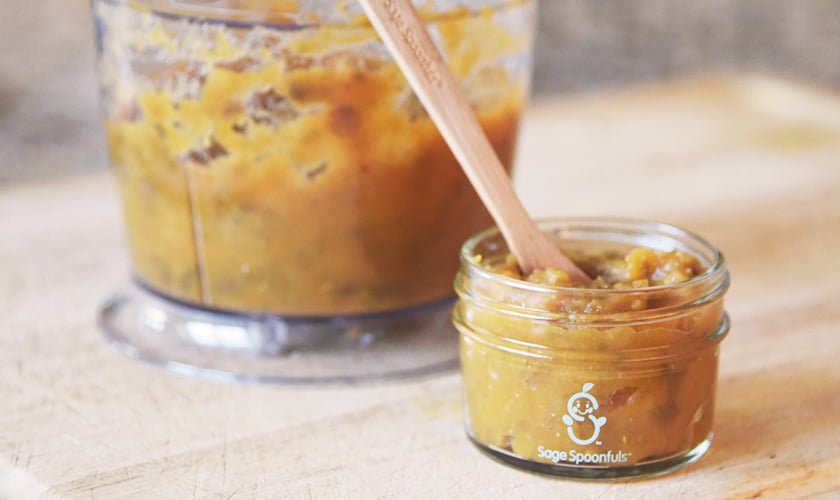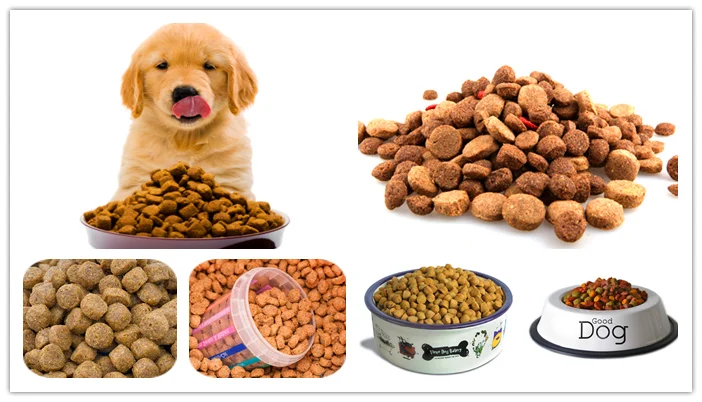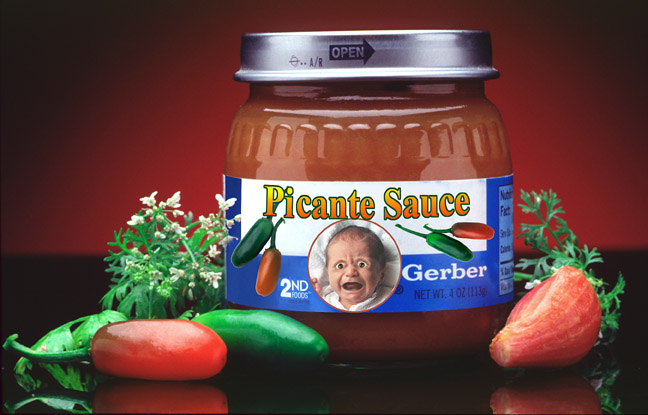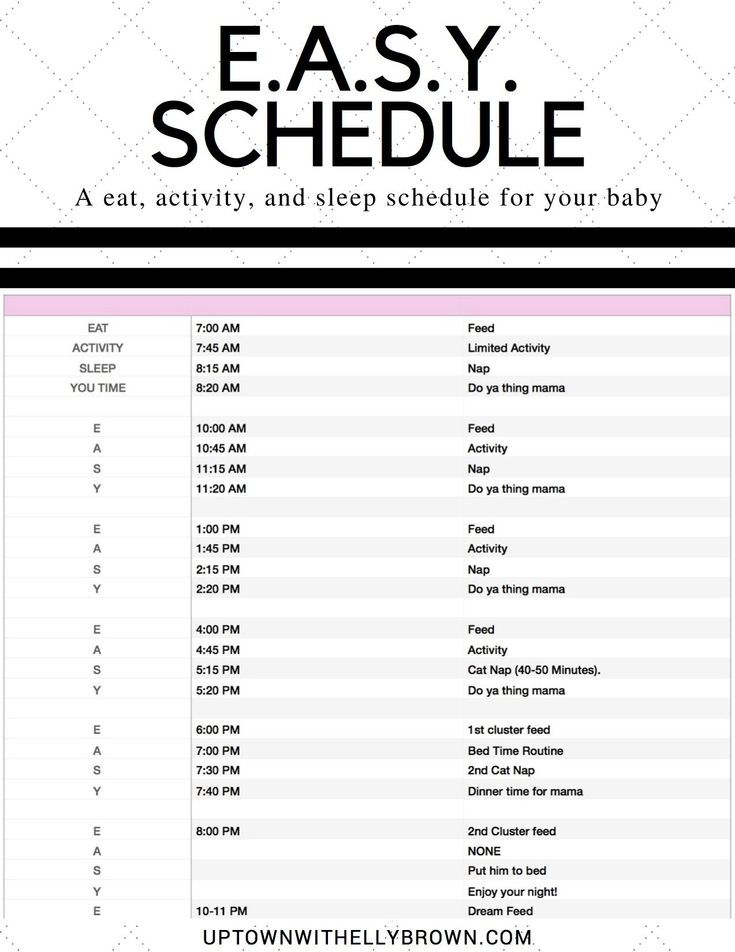Good food for 11 month old babies
Baby Food for 11-Month-Olds: Menus, Recipes, and Ideas
What are good baby foods for 11-month-olds?
It may seem like your baby was breastfeeding exclusively until very recently, but at 11 months old, your baby can eat many of the same foods that the rest of the family eats.
There are still some foods that they shouldn't have and certain preparation methods that you need to follow. Here are some of the things to avoid when planning a menu for an 11-month-old:
- Sugar — Your baby doesn't need to consume added sugar, and this ingredient can lead to tooth decay. Avoid giving your baby sugary snacks or drinks, and don't add extra sugar to their food. Instead, offer them a variety of fresh, non-citrus fruit.
- Salt — Added salt isn't good for your baby's kidneys. You don't need to add salt to their food. If you're cooking a family meal that your baby can eat, set a portion aside for the baby before you season it.
Avoid salty snacks such as salty crackers, chips, and deli meats.
- Honey — Honey is delicious, but it can contain bacteria that cause botulism. Avoid giving your baby honey until their first birthday.
- Unpasteurized dairy products — Babies can eat pasteurized cheese when they're six months old, but unpasteurized cheeses can be harmful. Cheeses made with unpasteurized milk or mold-ripened cheeses, such as roquefort and brie, can contain a bacteria called listeria. Instead, offer your baby cheddar cheese, cottage cheese, and cream cheese.
- Cow's milk — Dairy products, such as yogurt or pasteurized cheeses, are a great addition to your 11-month-old baby's food list. However, they shouldn't drink cow's milk until they're at least one year old. Instead, give them formula, breastfeed them, or provide breast milk that was stored previously.
- Saturated fats — Avoid fried foods, processed meats, butter, baked desserts, cream, and mayonnaise.

- Highly processed foods — Your baby doesn't need to consume the additives, artificial colors, and flavorings that come in lots of processed foods such as candy, breakfast cereals, microwave meals, ice cream, and chips. These foods should be an occasional snack rather than a dietary staple.
- Whole nuts — Nuts and seeds can pose a choking hazard for your 11-month-old baby. Instead, you can offer them nut butter.
- Uncooked eggs — Make sure any eggs your baby eats are fully cooked to avoid possible salmonella infections. Avoid foods that contain raw eggs, such as cake batter or homemade mayonnaise.
- Raw fish or seafood — These foods carry an increased risk of food poisoning. Stick to fully cooked fish until your baby is at least one year old.
Take a quiz
Find out what you can do with our Health Assistant
How much food does an 11-month-old need?
It might be messy at first, but allowing babies to eat on their own can help them develop their fine motor skills, independence, coordination, and body and food awareness.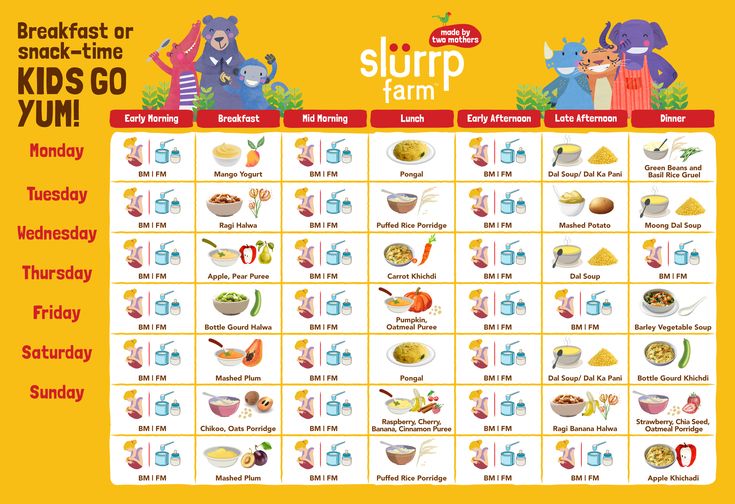 Don't force your baby to eat. Forcing babies to finish every meal can cause them to negatively impact their relationship with food. Make sure that you cut your baby's food into small pieces, and allow them to feed themselves while keeping a close eye on them.
Don't force your baby to eat. Forcing babies to finish every meal can cause them to negatively impact their relationship with food. Make sure that you cut your baby's food into small pieces, and allow them to feed themselves while keeping a close eye on them.
Here's a quick guide to the portion sizes that your 11-month-old baby needs each day:
- Protein: Up to 4 tablespoons
- Vegetables: Up to half a cup
- Fruits: Up to half a cup
- Cereals: Up to half a cup
- Dairy: Up to 3 tablespoons
- Breast milk or formula: 22 to 32 oz
If your child has already stopped breastfeeding, make sure they're still drinking formula or stored breast milk every day. You can also follow these tips to increase your breast milk if your supply has gotten too low. Breast milk or formula can provide up to half of your child's nutritional requirements until they're a year old. It's very likely that they'll want to breastfeed less frequently once solid foods are introduced; therefore, breastfeeding should be actively encouraged at this age.
Menu for 11-month-old babies
Here are some meal ideas for your 11-month-old baby:
Breakfast:
- Eggs and toast
- Blueberry whole-wheat pancakes
- Cheese sandwich
Lunch:
- Chicken and vegetables
- Macaroni and cheese
- Homemade lasagna
Dinner:
- Creamy chicken and vegetable soup
- Lean steak and vegetables
- Cereal with fruit
Snacks:
- Fruits and peanut butter
- Yogurt with cereal or fruit
- Boiled eggs
Food ideas for 11-month-old babies
Here are some ideas to help you come up with new recipes for your 11-month-old baby:
- Try new ways to cook your baby's vegetables. Rather than sticking to the usual ways you cook your vegetables, try grilling or sauteing them so that your baby experiences new textures and flavors.
- Create homemade versions of your favorite foods.
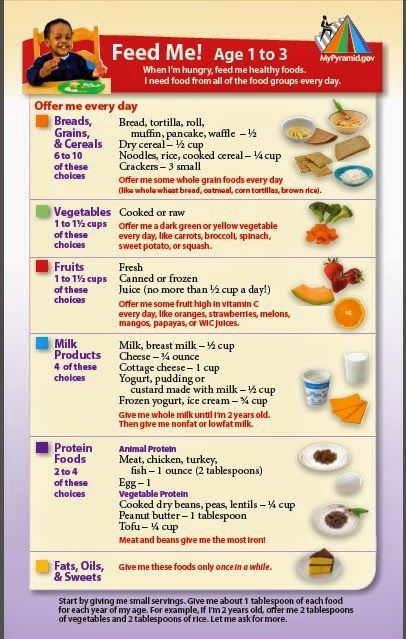 Your baby shouldn't be eating frozen lasagna or pizza, but you can cook healthier, homemade versions of your favorite meals so that they can try them.
Your baby shouldn't be eating frozen lasagna or pizza, but you can cook healthier, homemade versions of your favorite meals so that they can try them. - Only introduce one new food every couple of days. If you introduce too many new foods at once, and one of them causes an allergy, it will be hard to determine which one it was. Instead, introduce one food at a time and wait a few days before trying something else.
Recipes for 11-month-old babies
- Vegetable and chicken soup — Boil broccoli, potatoes, and a chicken breast. Then, blend the solid ingredients together and add some of the stock. This soup will have a creamy consistency, and you can even add some cheese on top.
- Homemade frozen smoothies — Freeze ripe bananas. Once they're frozen, blend them until they're smooth. You can add other fruits such as strawberries and blueberries. Keep it in the freezer for a healthy, cool snack.

- Homemade pizza — Use pita bread for the crust and puree some peeled tomatoes to make the sauce. Top with mozzarella cheese and fresh basil before placing it in the oven.
Food for your 11-month-old baby is very similar to food for the rest of the family. At this age, they'll be able to eat on their own and discover many wonderful new flavors, textures, and sensations. They'll be eating a piece of their own birthday cake very soon!
11 Months Old Baby Food Chart Along with Homemade Recipes
By the time your baby is 11 months old, he is likely to be able to eat on his own. You can give your baby the same food as the rest of the family after mashing it or cutting it into small pieces to help him chew and digest it better. Be sure to watch over your child during meal and snack times to make sure he does not choke on any food.
Video: Food Ideas for 11-month-old Babies
How Much Can a Baby Eat at This Stage?
By the time they are 11 months old, most babies can eat a wide range of items like fruits, vegetables, and meat. Three meals and a snack alongside formula or breast milk are what an average 11-month-old baby needs each day. The meal and snack timings will depend on your baby’s daily routine as well as yours.
Also Read: 11 Months Old Baby Milestones
How Much Quantity Per Day?
Your baby’s appetite will vary depending on his level of activity and his growth spurt to a large extent. The following is an approximate estimation of the quantity of food your baby needs each day:
- Up to half a cup of cereal
- Up to half a cup of vegetables
- Up to half a cup of fruits
- Up to 3 tbsp of dairy
- Up to half a cup of mixed cereals
- Up to 4 tbsp of meat or other proteins
How to Check If Your Baby Is Getting Enough Breast Milk or Formula
While feeding your baby, a few concerns are bound to creep up every now and then.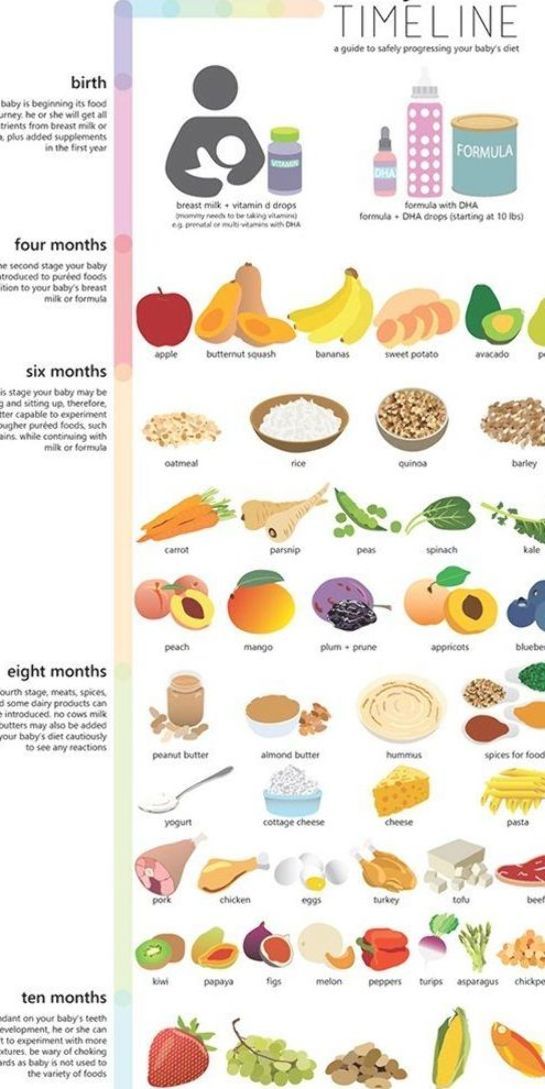 You might wonder if your child is getting enough milk or formula every day – here are some ways in which you can assess this:
You might wonder if your child is getting enough milk or formula every day – here are some ways in which you can assess this:
Breastfed Baby:
- If your baby appears content after every feed, it is an indication that he is getting enough milk.
- When you experience a let-down, it is an indication that breastmilk is being replenished on a regular basis.
- Check your baby’s urine and see if it is clear and odourless. That is a sign of a well-fed baby.
- Your baby has regular bowel movements.
Formula-fed Baby:
- Convert your baby’s weight into pounds and multiply it by 2 and 2.5 to get two values that will be considered as lower and upper ranges for the amount of formula your baby needs each day.
- As your baby approaches his first birthday, the formula feed is likely to decline to just one big feed per day.
- See if your baby wets a minimum of six diapers in a 24-hour period.
Best Foods for Your Eleven-month-old Baby
It is important to cultivate healthy eating habits in your baby right from an early age. So, keep a watch for any possible allergies and introduce your child to all kinds of foods.
So, keep a watch for any possible allergies and introduce your child to all kinds of foods.
1. Fruits
A great source of vitamins and minerals, fruits should be an integral part of your baby’s daily diet. From apples to oranges to bananas and pears, let your baby try everything.
2. Poultry and Fish
Packed with proteins, fish and chicken can be extremely helpful in your child’s brain development and growth.
3. Cheese
Different types of cheese like cottage, cheddar, ricotta, and goat cheese can enhance the taste of your baby’s meals while satisfying daily protein requirements.
4. Pulses and Grains
Everything under this category can be offered to your 11-month-old baby. Switch between grains and pulses to give your baby some variety during mealtimes.
5. Dairy Products
Dairy items like yoghurt and curd are good for infants. Refrain from feeding your baby cow’s milk – that can be given only after the age of 1 year.
6.
 Leafy Greens
Leafy GreensLeafy vegetables, especially greens such as spinach and fenugreek are particularly beneficial to babies as they contain iron.
7. Vegetables
All kinds of vegetables are good for your baby. Make it a point to use three different vegetables – one at every meal – every day.
8. Eggs
Eggs, especially the yolk is good for babies at this age. It is also easy for them to eat and digest.
Video: Diet Plan for 11 Month Old Baby
11-month-old Baby Food Chart/Meal Plan
Here is a sample meal plan for an 11-month-old baby:
Diet for a 11 Month-Old – Week 1, Day 1
Diet for a 11 Month-Old – Week 1, Day 2
Diet for a 11 Month-Old – Week 1, Day 3
Diet for a 11 Month-Old – Week 1, Day 4
| Early morning | Mother’s milk /formula feed |
| Breakfast | |
| Mid-morning | Mashed papaya |
| Lunch | Curd rice |
| Evening | Mother’s milk /formula feed |
| Dinner | Bajra (pearl millet)- moong dal (green gram split) khichdi |
Diet for a 11 Month-Old – Week 1, Day 5
Diet for a 11 Month-Old – Week 1, Day 6
Diet for a 11 Month-Old – Week 1, Day 7
Diet for a 11 Month-Old – Week 2, Day 1
| Early morning | Mother’s milk /formula feed |
| Breakfast | |
| Mid-morning | Mashed chikoo (sapota) or mashed banana |
| Lunch | Roti dipped in dal |
| Evening | Mother’s milk /formula feed |
| Dinner |
Diet for a 11 Month-Old – Week 2, Day 2
Diet for a 11 Month-Old – Week 2, Day 3
Diet for a 11 Month-Old – Week 2, Day 4
Diet for a 11 Month-Old – Week 2, Day 5
Diet for a 11 Month-Old – Week 2, Day 6
Diet for a 11 Month-Old – Week 2, Day 7
Diet for a 11 Month-Old – Week 3, Day 1
Diet for a 11 Month-Old – Week 3, Day 2
Diet for a 11 Month-Old – Week 3, Day 3
Diet for a 11 Month-Old – Week 3, Day 4
Diet for a 11 Month-Old – Week 3, Day 5
Diet for a 11 Month-Old – Week 3, Day 6
Diet for a 11 Month-Old – Week 3, Day 7
Diet for a 11 Month-Old – Week 4, Day 1
Diet for a 11 Month-Old – Week 4, Day 2
Diet for a 11 Month-Old – Week 4, Day 3
Diet for a 11 Month-Old – Week 4, Day 4
Diet for a 11 Month-Old – Week 4, Day 5
Diet for a 11 Month-Old – Week 4, Day 6
Diet for a 11 Month-Old – Week 4, Day 7
Video: 11-month-old Baby Food Recipes
Homemade Baby Food Recipes
1. Semolina (
Suji) HalwaIngredients
- ½ cup semolina (suji)
- 1 cup of water
- ½ tsp powdered cashews/almonds (optional)
- ½ tsp ghee
- 1 date, pureed
How to Prepare
Warm the ghee in a pan and then roast the semolina in it. Keep stirring to avoid burning. When the semolina turns aromatic, add the water and date puree. Stir to prevent lumps, and if you are using the powdered dry fruits, you can add them in at this point. When the semolina appears cooked, turn off the heat. Keep the consistency of the halwa a little thin as it will thicken further while cooling.
2. Spinach and Cottage Cheese (
Paneer) PastaIngredients
- 1 cup pasta (penne or macaroni)
- 1 bunch spinach
- 1 cup grated cottage cheese (paneer)
- Water as required
- Salt if required
How to Prepare
First, cook the pasta and ensure it is soft enough for your baby to eat easily. You can also mash it lightly if you want. Wash the spinach well and boil it for a while. Add the cottage cheese to it and cook for a few minutes till the raw smell and taste disappear. Cool this mixture and grind it to a smooth paste with a little water. You can also add in a little salt if required. Mix this with the pasta and serve it to your baby.
You can also mash it lightly if you want. Wash the spinach well and boil it for a while. Add the cottage cheese to it and cook for a few minutes till the raw smell and taste disappear. Cool this mixture and grind it to a smooth paste with a little water. You can also add in a little salt if required. Mix this with the pasta and serve it to your baby.
3. Creamy Carrot and Sweet Corn Rice
Ingredients
- ¼ cup chopped onion
- ½ cup boiled sweet corn
- ¼ cup carrot peeled and chopped
- ½ cup of rice
- 1 tbsp butter
- A bay leaf
- A pinch of pepper powder
- Water as required
How to Prepare
Heat the butter in a pan and sauté the onions in it until translucent. Add the cooked and boiled corn to this. Next, add the chopped carrots and pepper. Saute for a while and turn off the heat. You can cool this and roughly or smoothly grind the mixture depending on your child’s preferences. Boil water to cook the rice and add the bay leaf. Cook the rice till it is soft enough for your baby to eat. Stir in the mixture and remove the bay leaf. Serve it warm to your baby.
Boil water to cook the rice and add the bay leaf. Cook the rice till it is soft enough for your baby to eat. Stir in the mixture and remove the bay leaf. Serve it warm to your baby.
4. Apple Chicken Nuggets
Ingredients
- 1 egg yolk
- 1 apple- peeled and grated
- 1 clove of garlic
- 1 cup chicken minced or ground finely
- A pinch of pepper
- A pinch of thyme, finely powdered
- Some oil to grill/fry
How to Prepare
Mix the listed ingredients except for the egg yolk. Then shape the mixture into small nuggets. Beat the egg yolk well and brush it on the nuggets – you can also dip the nuggets in the beaten egg yolk. Shallow fry or grill the nuggets till the chicken is cooked well. Using olive oil can make the nuggets more crispy and flavorful.
5. Kidney Bean (
Rajma) SoupIngredients
- 1 small onion, chopped finely
- ½ cup kidney beans (rajma) soaked overnight
- 2 cloves of garlic, finely chopped
- 1 small tomato- finely chopped
- 2 tsp lemon juice
- 1 tsp butter
- A pinch of black pepper powder
- Salt if required
- Water as required
How to Prepare
Place a pressure cooker on heat and melt the butter. Add the chopped garlic and sauté it for about a minute. Then put in the onions and stir fry till they become soft. Then add the chopped tomato and sauté till it becomes pulpy. Add the soaked kidney beans to this and sauté for a few minutes. Pour in two cups of water and cook the beans well in the cooker till they are soft enough to mash. Blend the mixture to a soup consistency and boil it. Add the lemon juice and pepper along with some salt if you want. Serve in a bowl.
Add the chopped garlic and sauté it for about a minute. Then put in the onions and stir fry till they become soft. Then add the chopped tomato and sauté till it becomes pulpy. Add the soaked kidney beans to this and sauté for a few minutes. Pour in two cups of water and cook the beans well in the cooker till they are soft enough to mash. Blend the mixture to a soup consistency and boil it. Add the lemon juice and pepper along with some salt if you want. Serve in a bowl.
Feeding Tips to Feed Your Eleven-month-old Baby
Compiling an 11-month-old baby food list and using it as a reference can simplify things for you.
- Sterilise utensils like spoons, plates, bowls and glasses that you will use to feed your baby. You can immerse these in hot water for a few minutes and take them out when you are ready to serve the food.
- Every time you introduce a new healthy food, be sure to keep an eye out for any signs of allergies. Also, be sure to give a gap of at least three to five days before introducing the next new food and only introduce one food at a time.

- Try to avoid sugar and salt in your baby’s food at least until the first birthday. Cow’s milk and honey are also not advised unless your baby turns one.
- Be sure to supplement your baby’s solid feeds with breast milk or formula based on your child’s demands.
- Check with your paediatrician if you have any concerns about your child’s feeding habits.
Your baby is growing up fast and starting to explore the world around him. So, this is the right time to introduce your baby to new foods one at a time and gradually get him to eat what the family eats. Just ensure that the food you offer your child is as healthy and home-cooked.
Disclaimer:
- Each child is different and so use these meal plans as a trusted guide as per your discretion. You can modify the meals according to your child’s preferences / requirements.
- Never force-feed a child.
- While preparing formula, please follow the instructions on the box and use the measuring spoon provided with it.
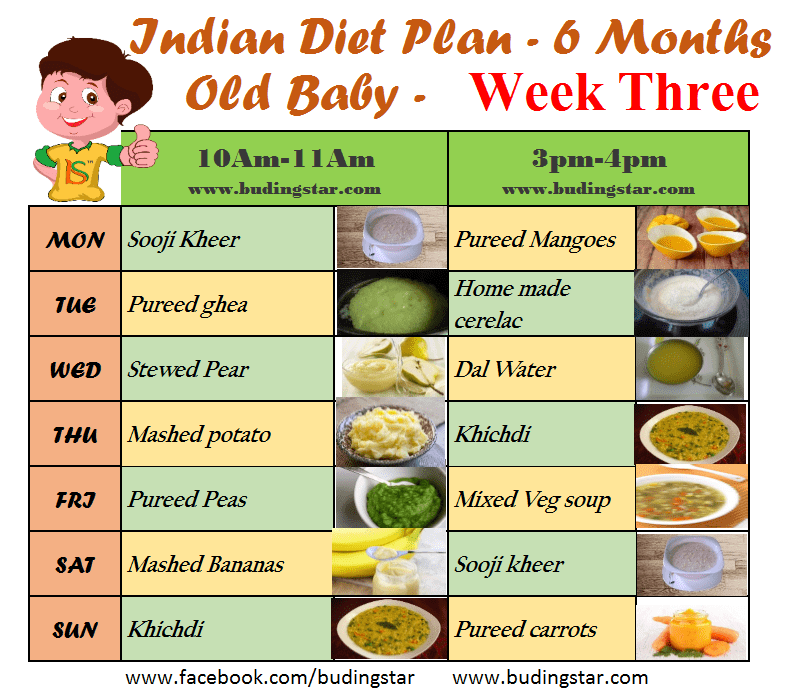
- While introducing solid food to a baby, initially, one needs to prepare watery gruels/soups. As a child gets older, the caretaker/ mother has to increase the thickness of the liquids slowly according to the child’s capacity to swallow. Foods that are too thick can cause stomach upset/ unnecessary load; while excessively watery food might cause the child to remain hungry.
- Some kids may eat less on some days and that is absolutely alright. However, if a child eats less for more than 3-4 consecutive days, please visit a doctor to guide further.
- A child may eat less during the teething phase or if he/she may not be feeling well. You could increase breast milk /formula feeds on those days. Re-introduce the foods once the child is back to normal.
- Don’t stop feeding if the child is suffering from diarrhoea.
- You can alter the taste of the food by adding some natural flavours like cinnamon, jeera powder, lemon juice, curry leaves etc. if the child doesn’t accept the food initially.

- If your child suffers from an allergy to nuts, gluten or eggs, please consult your doctor before feeding him/her any foods that may contain them.
Also Read:
Healthy Egg Recipes For Babies & Kids
10 Simple & Healthy Rice Recipes For Kids
What can a baby eat at 11 months sample menu for a week with recipes and diet
Skip to content
Search for:
FAQ
Reading 27 min Views 94 Updated
At 11 months, the baby is already eating a variety of foods. In order for the baby to grow up healthy, and his organs and systems to work harmoniously, only healthy dishes should be on the menu. We will tell you more about what to feed your baby at 11 months.
We will tell you more about what to feed your baby at 11 months.
Contents
- Peculiarities of the child's diet
- Norms of food in the child's diet at 11 months
- Daily diet
- What changes have occurred in the diet
- What to do if the child does not eat well
- Menu for an 11-month-old baby: sample diet
- What to feed
- When to feed
- What to drink
- What not to feed
- How to cook
- Nutrition for a baby at 11 months: what foods can I give and how much?
- Basic nutrition rules
- Baby's diet
- What can I feed a baby at 11 months
- Breastfed babies
- Formula babies
- Menu of a baby at 11 months breastfed
- What should be the diet
- What should be the diet
- 1-day menu of the child at 11 months
- Weekly diet of the child
- Prohibitions and nutrition
- Toddler is still not allowed:
The list of allowed products at 11 months is quite diverse, so mothers have the opportunity to fantasize in the kitchen and show their culinary skills.
- Vegetables. Vegetables are the foods that start complementary foods for a baby. At this age, the mother cooks soups, stews for the baby based on them, prepares mashed potatoes, adds them to cereals, mixes them with meat, fish, squeezes juice. Here are the vegetables the baby eats at 11 months: zucchini, cabbage (cauliflower, Brussels sprouts, broccoli), carrots, onions, potatoes, pumpkin, beets, green peas, asparagus. At this age, he can eat fresh vegetables (with the peel removed), chopped on a coarse grater and seasoned with sunflower oil, sour cream. A little finely chopped greens (dill, parsley) are also added to such a vitamin salad. You can introduce a baby at 12 months of age with white cabbage. Start giving it with a minimum amount and only in boiled form. You can add cabbage to soups, stews, mashed potatoes, cutlets. Many pediatricians recommend starting to feed the baby with eggplant. However, caution should be exercised here, as this vegetable contains solanine.
 To reduce its amount, blue ones need to be soaked in salted water before processing. Be sure to peel the skin so that the baby does not choke while eating. Eggplants are included in soups, stews and vegetable purees. Allergic children and those who have problems with the digestive tract should not eat blue ones yet. nine0018
To reduce its amount, blue ones need to be soaked in salted water before processing. Be sure to peel the skin so that the baby does not choke while eating. Eggplants are included in soups, stews and vegetable purees. Allergic children and those who have problems with the digestive tract should not eat blue ones yet. nine0018 - Fruit. Fruits are the main source of vitamins and trace elements necessary for a growing organism. At 12 months of life, the baby has already met many fruits. 11 months is the age when you can introduce your child to pomegranate and citrus fruits. It is better to give preference at the initial stage to tangerines, grapefruit and orange. You need to start with a small slice. If no adverse reactions are observed, let the baby taste pomegranate, orange, tangerine juice. They should be diluted with water in a ratio of 1:3. After that, other fruit juices (apple, pear, peach) can be added to drinks. On the basis of fruits, salads, compotes, kissels are prepared, they are mixed with cottage cheese, porridge.
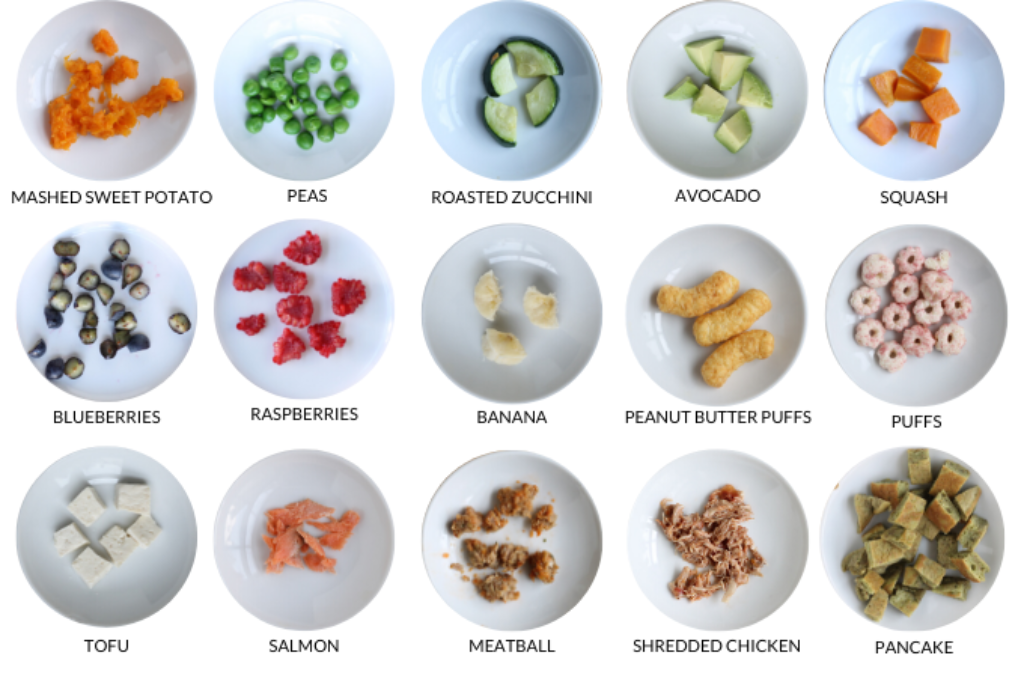 nine0018
nine0018 - Meat. In the menu of a child on artificial feeding, as well as on natural, there are already meat of turkey, rabbit, veal, beef, horse meat, lean chicken and pork. At this stage, the baby can already be safely introduced to the liver, heart and tongue. Meat puree is added to soups, cereals, vegetable puree. Meatballs, cutlets, meatballs, dumplings are boiled on its basis, a tender soufflé is made. It is recommended to cook meat for a couple, stew. Frying and baking at this age are excluded. It is forbidden to offer the baby sausages, sausages, lard. nine0018
- Fish. Enter in the menu of a child on breastfeeding, as well as on artificial, you need only fish of low-fat varieties. These are pollock, flounder, hake, pike perch, cod, sea bass. It is better to wait a little with bold and fatty varieties, although according to some recommendations, such fish can also be introduced into the diet in small quantities. Processing of fish should be only steam.
 Preference should be given to fresh fish. Fish-based dishes are still served twice a week. On other days, it is recommended to offer the baby meat. From fish you can make cutlets, dumplings, soufflés, add to soups, vegetable purees. nine0018
Preference should be given to fresh fish. Fish-based dishes are still served twice a week. On other days, it is recommended to offer the baby meat. From fish you can make cutlets, dumplings, soufflés, add to soups, vegetable purees. nine0018 - Dairy products. Fermented milk products contain bacteria beneficial for the intestinal microflora, which contribute to the smooth functioning of the digestive system. Therefore, such products must be included in the diet of crumbs daily. Dairy products should not replace full feeding. Kefir, yogurt, cottage cheese are served only in addition to the main dishes. At 11 months, the child can be safely introduced to sour cream. It is allowed to add the product to vegetable salads, flavor it with soups, borscht, water meatballs, meatballs, add to casseroles, etc. Yogurt, sour cream and cottage cheese can be mixed with fruits and berries. Serve best for breakfast and during the fourth meal. An important condition is the use by the baby of fermented milk products prepared independently or purchased in the children's kitchen.
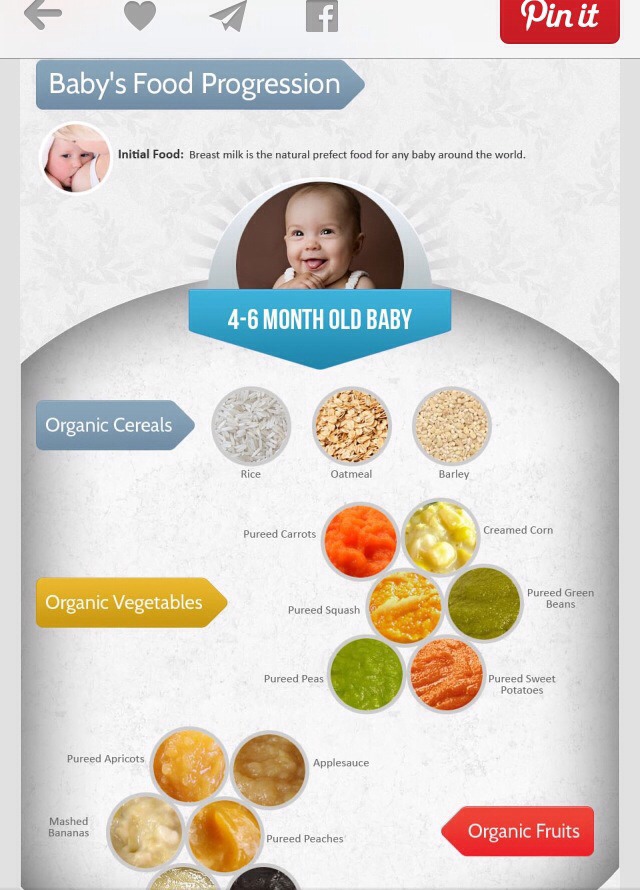 nine0018
nine0018 - Berries. Berries must be included in the diet of a child at 12 months of age. The main condition is the use of only seasonal berries. At this age, the baby has already tried: gooseberries, currants (black, yellow, red). Some pediatricians recommend expanding the baby's diet and introducing him to watermelon, strawberries, cherries, cherries and raspberries (unless, of course, you are confident in the quality and freshness of the berries). Just be sure to watch the reaction of the crumbs. The kid will definitely love berries if you add them to cottage cheese, porridge. As for fruit drink, before serving it should be diluted with water in a ratio of 1: 3. nine0018
- Drinks. During the day, the baby must drink clean water. To avoid anemia and beriberi, the baby needs to drink juices based on fruits and berries, compotes, including dried apricots, prunes, raisins, as well as jelly, fruit drinks, children's herbal teas. In no case should you give a child at 11 months of age black tea, store-bought juices, drinks sweetened with sugar or honey.
 This can significantly harm the health of the baby.
This can significantly harm the health of the baby. - Kashi. Porridges at 11 months are given the most diverse - at the discretion of the mother and depending on the taste preferences of the child. Porridges are boiled in water, mother's milk, artificial mixture. At the end, you can add a piece of butter. The kid will really like it if you put berries or pieces of fruit in the porridge. nine0018
What else can be given to a child at 11 months?
Here is a list of foods that should also be included in the diet of an 11-month-old baby.
- Yolk . Serve the yolk to the table (preferably from quail eggs) should be no more than 2 times a week.
- Raisin croutons, biscuits. May be served daily.
- Oils. Butter and vegetable oils, extra virgin olive oil. Served every day. nine0018
- Green. Dill, parsley, celery. They are added to soups, salads, meat and fish dishes.
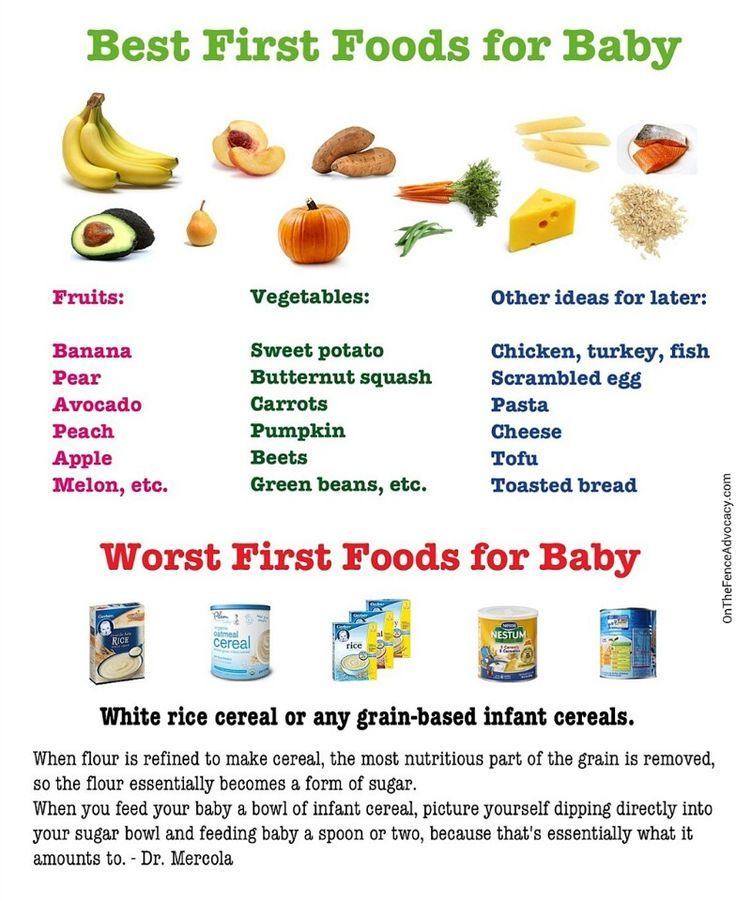 May be served daily.
May be served daily.
Norms of foods in the diet of a child at 11 months
To determine the exact amount of food that a child at 11 months should consume per day, you should divide his weight by 9. So, if the baby weighs 10 kg, then on average, he consumes from 1100 to 1250 g. That is, the amount of food for each meal is at least 220-250 g. As for the amount of liquid consumed per day, it can also be easily calculated: 50 ml of liquid is needed per 1 kg of a child's weight. That is, at 10 kg of weight, the baby drinks 500 ml per day. Formula-fed babies should receive 20% more water than babies. The amount of liquid in hot weather increases by 10-20%. The recommended quantity of individual products is shown in the table. nine0003
| Vegetables | 200 g |
| Fruit | 110 g |
| Juice made from fruits, vegetables | 110 ml |
| Kefir or yogurt | 180-200 ml |
| Cereal porridge | 200 g |
| Cottage cheese (no more than 2-3 times a week) | 50 g |
| Meat | nine0136 80 g|
| Fish (twice a week) | 60 g |
| Vegetable and butter | by 5 g |
| Rusks, biscuits, bread | 10 g |
| Green | 5 g |
| Smetana | 1 tsp |
| Egg yolk (twice a week) | 1/2 |
Daily diet
It is worth noting that the diet of the crumbs remains the same, that is, five times a day.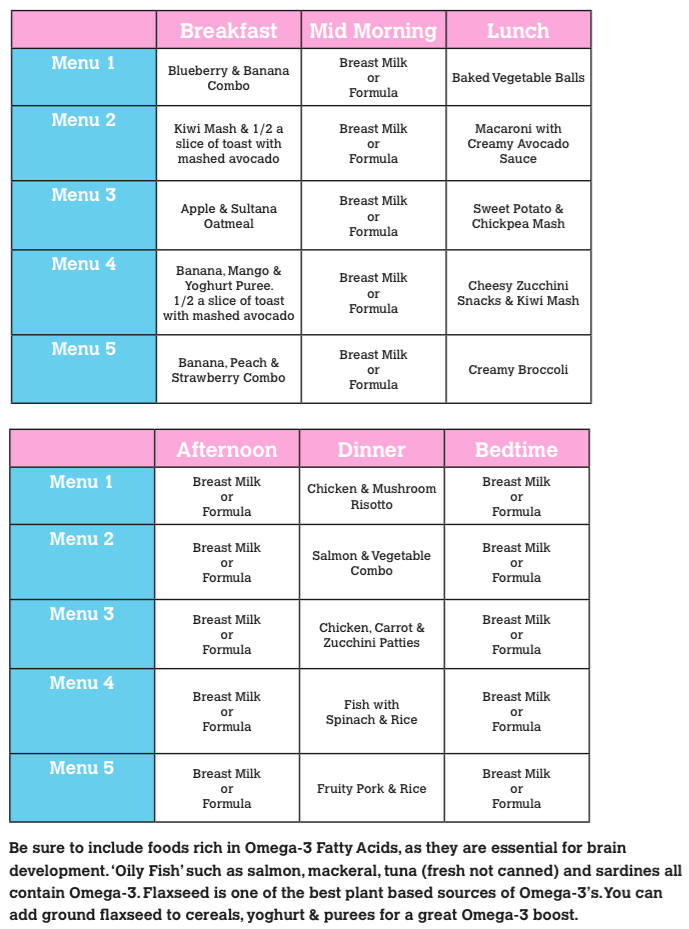 Breastfeeding or artificial feeding continues up to 1 year. Usually at this age, the baby requires his mother's breast or a bottle of formula in the evening or early in the morning, the rest of the time he eats only adult food. There is no need to supplement with breast milk or formula. nine0003
Breastfeeding or artificial feeding continues up to 1 year. Usually at this age, the baby requires his mother's breast or a bottle of formula in the evening or early in the morning, the rest of the time he eats only adult food. There is no need to supplement with breast milk or formula. nine0003
Important! There are no differences in the nutrition of breastfed babies and those who eat artificial formula. At 11 months, babies eat the same foods.
So, what can a baby eat at 11 months, what drinks are allowed to drink? Here is a table that shows the time of a meal and what foods can be offered at this meal.
| Breakfast 6.00-7.00 | Mother's milk or formula. nine0137 |
| Late breakfast 10.00-11.00 | For breakfast, the baby is provided with easily digestible carbohydrates, that is, cereals - buckwheat, oatmeal, corn, rice. The choice in this case is huge. Be sure to fill the porridge with oil, diversify with berries. As an option - slices of fruit, pieces of pumpkin. Breakfast is also served with cottage cheese, kefir or yogurt. For dessert, the baby is offered fruit puree or juice from berries and fruits. As an option - slices of fruit, pieces of pumpkin. Breakfast is also served with cottage cheese, kefir or yogurt. For dessert, the baby is offered fruit puree or juice from berries and fruits. |
| Lunch 14.00-15.00 | nine0136 Soup or puree of boiled vegetables with herbs, any cereal with vegetable oil. Meatballs, cutlets, pate or mousse, poured with sour cream. 2 times a week you need to give fish in the form of mashed potatoes or cutlets, steamed dumplings. Quarter of yolk, bread. Compote.|
| Dinner 18.00-19.00 | Porridge, fruit puree, kefir, yogurt, fruit juice, raisin biscuits or crackers. |
| Second dinner 22.00-23.00 | Mother's breast milk or formula milk. nine0137 |
What changes have occurred in the diet
- The regime remains the same - 5 meals, the interval between which is 4 hours. You should not transfer the baby to 3 or 4 meals a day, which entails an increase in the volume of one serving.
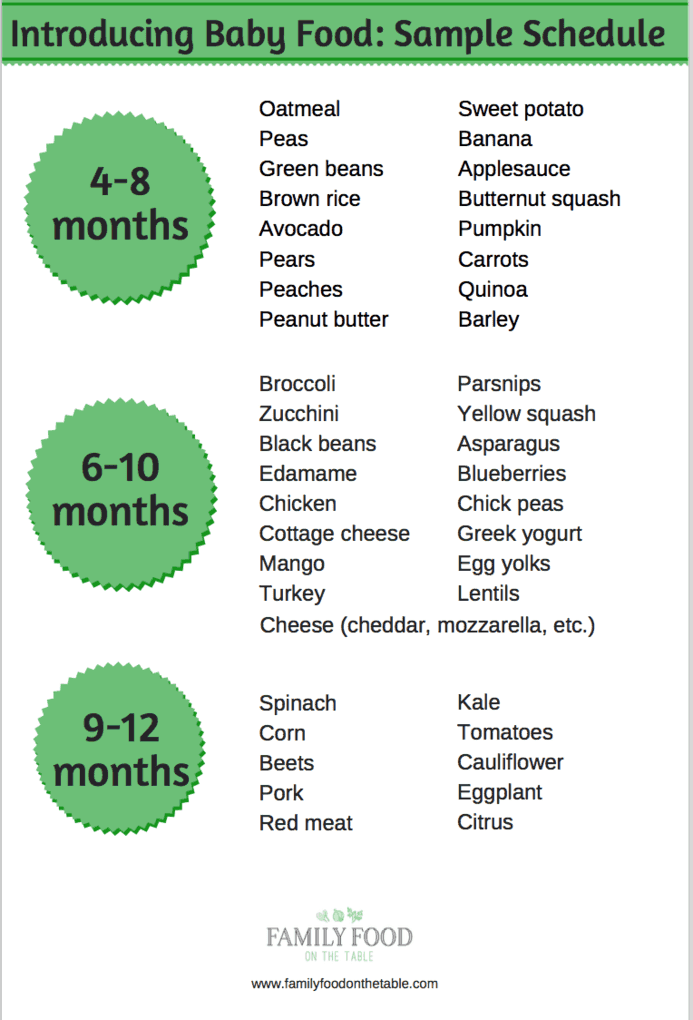 This causes a disruption in the digestive system, which is not able to cope with such an amount of food.
This causes a disruption in the digestive system, which is not able to cope with such an amount of food. - At this age, the child already eats almost all foods from the adult table. The following are still banned: smoked meats, sausages, cow's milk, canned food, sweets, mushrooms, nuts, semi-finished products, black tea, etc.
- At the age of 12 months, there is no need to grind food on a fine grater or with a blender. The child is already a happy owner of 4 (or maybe more) teeth, and therefore he is quite capable of chewing meat, fish, fruits and vegetables, mashed with a fork, cut into small slices, pieces (all the more it has a good effect on the development and functioning of the jaw muscles).
- Many babies still wake up at night, early in the morning and want their mother's breast or formula bottle. We recommend that you do not deny the child this pleasure yet and continue feeding up to 1 year. nine0018
- It's time to show the child how to hold a spoon and where to point it.
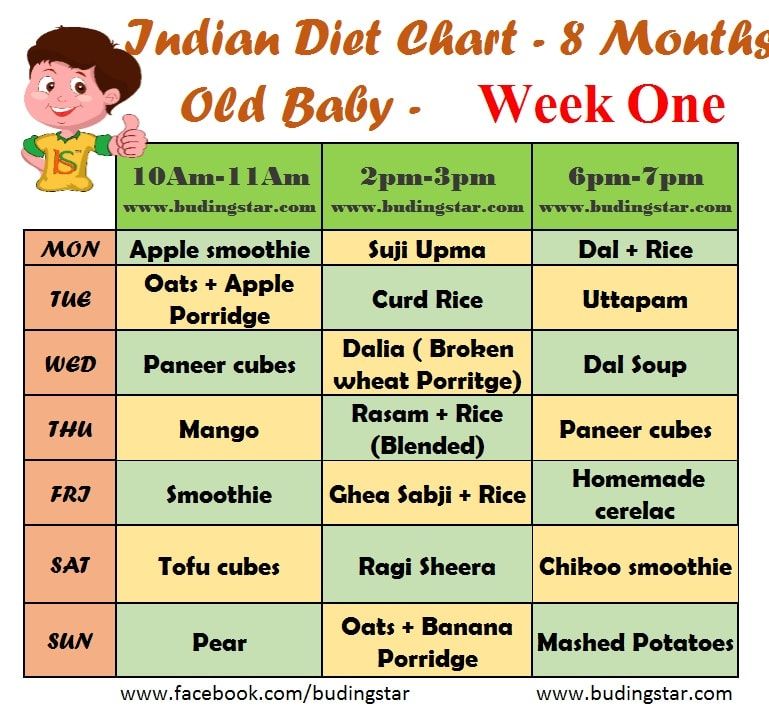 The same applies to mugs with his favorite drinks.
The same applies to mugs with his favorite drinks.
What to do if the child does not eat well
There can be many reasons for poor appetite in a child - a recent illness, ignoring the taste preferences of the baby, coercion in the process of feeding, disturbances in the daily routine, snacking between main meals, teething. All of these factors should be considered by parents. What can be done? nine0003
- If a child refuses pumpkin soup or doesn't like meatballs at all, this is no reason to force him to empty his plate. The baby may develop an aversion to food. Then it will be very difficult to instill a love for adult food.
- Poor appetite may also be due to snacking. You should not give the crumbs cookies or crackers before the main meal. This may affect the child's appetite.
- It is very important for a good appetite to observe the daily routine. If you stick to the same schedule every day, then the child will develop the need to eat at the right time.
 nine0018
nine0018 - Try to take into account the preferences of the child, include different products in the menu, prepare new dishes, make them beautiful, then the baby's appetite will noticeably improve.
Video how to feed a baby at 11 months
- 50 g cauliflower;
- a quarter of a carrot;
- 50 g courgette without skin;
- sprig of dill;
- 50 g buckwheat.
Place a small pot of water on the stove. After boiling, throw well-washed buckwheat, chopped vegetables into the container. Boil for 10-15 minutes. Add chopped greens. Leave to sweat for another 2-3 minutes. Mash the vegetables with a fork. Add a teaspoon of olive oil, stir. nine0003
Vegetable stew
- marrow - 40 g;
- cauliflower - 40 g;
- broccoli - 30 g;
- quarter onion;
- a quarter of a carrot;
- 30 g peas.
Rinse and peel the vegetables, cut into small cubes, divide the cabbage into florets and place in a heavy-bottomed dish.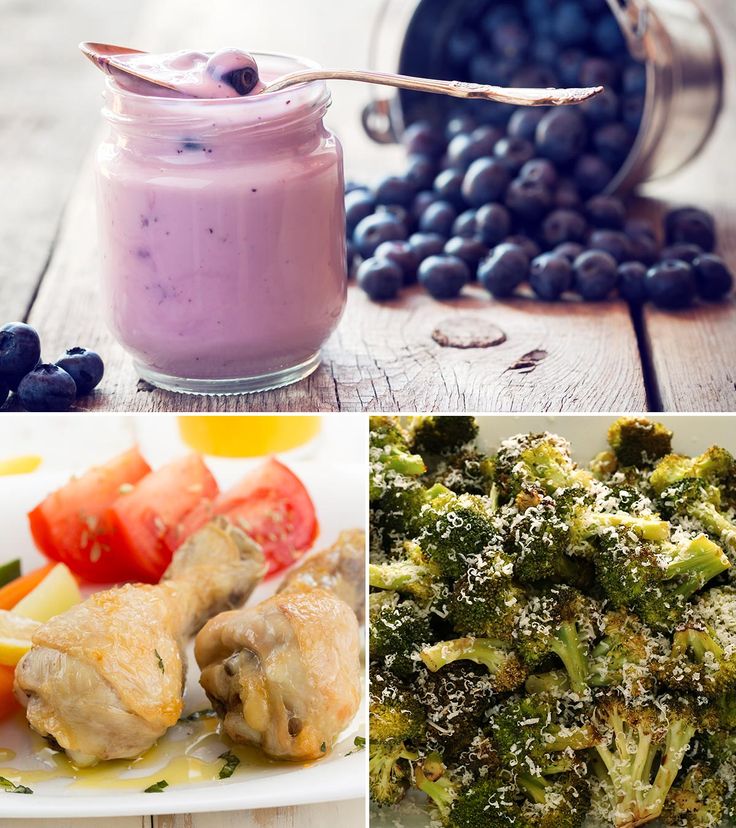 Add some water and simmer for about half an hour. Then add green peas and simmer over low heat for another 5-7 minutes. Drizzle with vegetable oil before serving. nine0003
Add some water and simmer for about half an hour. Then add green peas and simmer over low heat for another 5-7 minutes. Drizzle with vegetable oil before serving. nine0003
Borsch beets - 50 g;
- potatoes - 50 g;
- onion - a quarter;
- carrot - a quarter;
- sprig of parsley;
- sour cream - 1 tsp.
Fill a small saucepan with water and bring to a boil. Peel vegetables, wash, cut into small cubes. First put the beets in the water. Leave to simmer for 10 minutes, then toss in the rest of the vegetables. Boil for another 15 minutes. Add chopped greens, sweat for another 2-3 minutes. Serve the baby with sour cream. nine0003
Chicken cutlets with dill, onion
- chicken fillet - 100 g;
- onion - a quarter;
- egg;
- sprig of dill.
Turn the chicken fillet into minced meat, and the onion into a mush (can be finely chopped). Mix the ingredients, add the egg and chopped greens. Stir again. Treat with steam no more than 20-25 minutes.
Mix the ingredients, add the egg and chopped greens. Stir again. Treat with steam no more than 20-25 minutes.
Chicken quenelles
- chicken fillet - 100 g;
- white bread - 10 g;
- 2-3 st. l. breast milk;
- butter - 5 g.
Grind the fillet with a meat grinder or blender, add the egg. Place the bread in a bowl and pour in the milk. Put in the microwave. When the bread is soaked, add it to the minced meat along with softened vegetable oil. Stir. Form the quenelles with wet hands. Processing should be steam. Cooking time - 20-25 minutes.
Turkey meatballs with vegetables and rice groats
- fresh turkey fillet - 100 g;
- quarter onion;
- a quarter of one carrot;
- 50 g pumpkin without skin;
- rice - 40 g.
Cook rice until tender (10 minutes after boiling). Twist the fillet through a meat grinder. Chop the onion, pumpkin and carrot.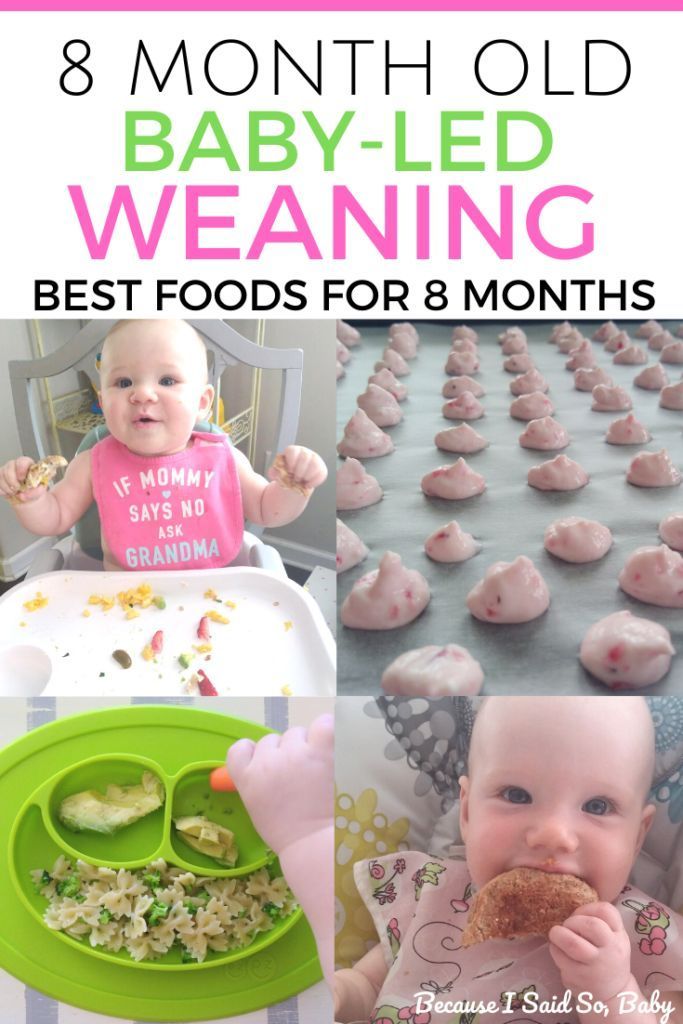 Mix all products, make small balls. Put a saucepan or cauldron on the stove, put the meatballs, add water (to cover them). Cover the container with a lid. Simmer for 30 minutes. Serve with sour cream. nine0003
Mix all products, make small balls. Put a saucepan or cauldron on the stove, put the meatballs, add water (to cover them). Cover the container with a lid. Simmer for 30 minutes. Serve with sour cream. nine0003
Hake cutlets with rice
- fresh hake (pollock) fillet - 100 g;
- egg yolk;
- white bread pulp;
- rice - 30 g.
Fillet mince, mix with pre-boiled rice. Add soaked bread and egg yolk. Combine the ingredients. Blind cutlets. Get ready for a couple. 15 minutes will be enough.
Pear basket with strawberries and raspberries
- one ripe pear;
- 20 g raspberries;
- 4-5 strawberries.
Rinse the pear, make a hole inside. Cut the strawberries into pieces and, together with the raspberries, place inside the pears. Put in the oven for a quarter of an hour.
You can come up with various dishes from a variety of products, the main thing is to arrange them beautifully before serving.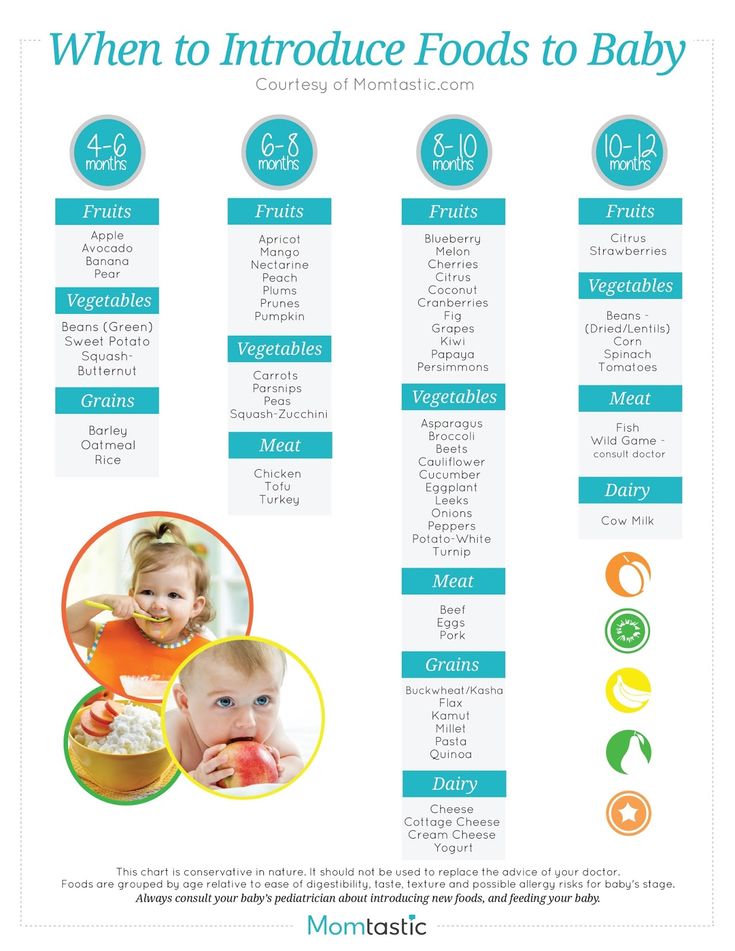
The time for one-component purees is over. Now mom is free to experiment: there are a lot of products on the list of allowed products that can now be mixed, besides, the baby is already used to a denser consistency of dishes. So, what to feed a baby at 11 months? nine0003
What to feed
The daily menu of an 11 month old baby ideally includes foods from all major groups of the food pyramid. Namely:
- Cereals . The baby can already have buckwheat, rice, corn, oatmeal, wheat and millet porridge. The approximate daily allowance for an eleven-month-old baby is 200 grams.
- Vegetables . Zucchini, broccoli, cauliflower and white cabbage, carrots, pumpkin, potatoes, beets, tomatoes, onions. A child can eat about 150 grams of vegetable dishes per day. nine0018
- Meat and fish . For a baby, it is better to cook rabbit, turkey, chicken and beef. The norm per day is 40-50 grams of meat puree from a boiled product or 80-100 grams of meat “in a jar”.
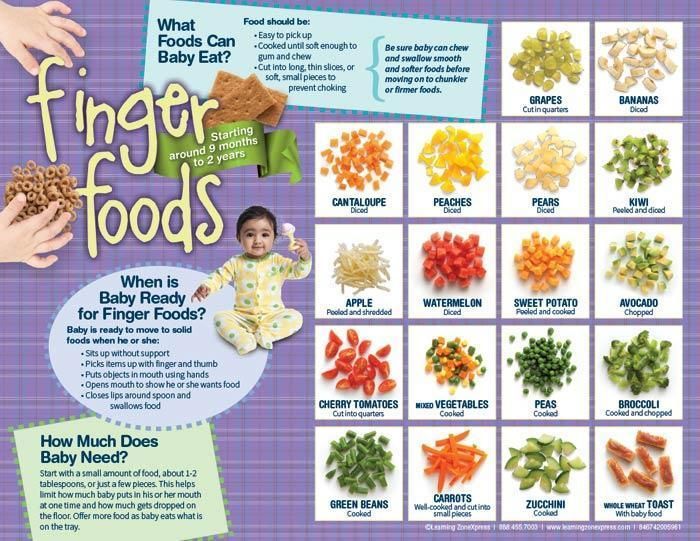 As a meat portion, you can sometimes give dishes from offal: tongue, liver or heart. A couple of times a week it’s good to arrange a “fish day”. A serving of fish now can be 30-60 grams. Among those allowed for baby food: sea - flounder, cod and pollock; river - hake, carp and river perch. nine0018
As a meat portion, you can sometimes give dishes from offal: tongue, liver or heart. A couple of times a week it’s good to arrange a “fish day”. A serving of fish now can be 30-60 grams. Among those allowed for baby food: sea - flounder, cod and pollock; river - hake, carp and river perch. nine0018 - Dairy products . At this age, the child is advised to give no more than 50 grams of cottage cheese. Fermented milk drink - kefir, biokefir, biolact, yogurt - about 200 grams.
- Fruit . Among the most friendly to the baby's digestive system are apples, pears, bananas, peaches, apricots, plums, currants (white, black and red). The norm of fruit puree is about 90-100 grams.
- Egg . A couple of times a week it is useful to give the baby half a chicken yolk, or a whole quail. Eggs for this should be boiled "hard boiled". A short heat treatment with the “soft-boiled” or “pouched” options does not destroy salmonellosis pathogens.
 nine0018
nine0018 - Oil . Vegetable oil goes well with vegetable dishes. The daily norm for a baby at 11 months is 6 grams. Creamy makes porridge tastier, 5 grams is enough for a child a day.
- Cookies . An eleven-month-old baby can be pampered with special baby biscuits. But you should not get carried away - two things a day are enough.
When to feed
It is not always possible to follow a strict regime with babies, but it is worth trying. Children who eat at regular intervals—with a maximum margin of error of 30 minutes—have better appetites and fewer digestion problems. nine0003
At 11 months, it is advised to feed the child five times a day, keeping four hours between meals. Immediately after sleep and at night, the baby still receives breast milk or an adapted milk formula.
A classic breakfast is porridge, cottage cheese, sometimes egg yolk.
Lunch is usually served with vegetables and meat (fish or offal). But the meat portion also goes well with a cereal side dish. Then vegetables can be given for breakfast or dinner.
But the meat portion also goes well with a cereal side dish. Then vegetables can be given for breakfast or dinner.
Fruit puree and any fermented milk drink are also suitable for dinner. nine0003
What to drink
Plain water is what a child needs to maintain water balance. You can buy bottled baby water or use boiled tap water. In second place are compotes from berries, fruits or vegetables familiar to the baby. Preferably without sugar.
Fruits and berries that are familiar to babies can also be used to make sparse jelly. The drink improves digestion, but since it is very high in calories, it is better not to give it to overweight children.
You should not get carried away with juices, although according to the norms they are allowed to drink 60-80 ml every day. They contain a lot of sugar and this is a disaster for delicate milk teeth. And the juices are rich in organic acids, which irritate the mucous membranes of the gastrointestinal tract. nine0003
What not to feed
There are foods on which, in the imagination of parents, there should be a “sign of an outcast”. They are absolutely not allowed in complementary foods. These are any canned foods, pickled vegetables and fruits, smoked meats.
They are absolutely not allowed in complementary foods. These are any canned foods, pickled vegetables and fruits, smoked meats.
Sausages, wieners and other sausages should not be given to a child, at least until the age of three. The same applies to cakes, pastries, chocolate, glazed curds. These are too "heavy" sweets. If you want to pamper your baby with sweets, then it is better to give him dried fruits, marshmallows or marshmallows. nine0003
Milk - cow's, goat's - will only bring harm to children under one year old. There is a lot of phosphorus in the product, and the kidneys of a child under one year old do not know how to remove it correctly. As a result, along with phosphorus, the baby loses calcium and vitamin D, and this is dangerous for the development of a severe form of rickets.
Honey sometimes contains spores that cause botulism. They are dangerous only for children under one year old.
It is also a mistake to give your baby dishes with mayonnaise, mustard, horseradish, pepper, vinegar and hot sauces.
How to cook
Baby food can be boiled, steamed, baked and stewed. Fried foods are taboo in baby food.
Vegetables and fruits no longer need to be thermally processed. They can be grated and served as a salad.
The meat can be used to make meatballs and meatballs. Moreover, at the “sculpting” stage, it is permissible to prepare them for several days at once and put them in the freezer. The next time, all that remains is to get the product and heat it.
For juiciness, you can add vegetable puree to minced meat: zucchini, carrots, cauliflower. nine0003
At 11 months, pediatricians allow the child to cook soups with meat broth. But when the water boils for the first time, it is advised to drain it. The "primary" broth is too fatty and contains most of the harmful substances that could be in the meat.
You can already add some greens to the soup: dill, parsley. The leaves must first be finely chopped.
It makes sense to add vegetable and butter only to ready meals. Heat treatment deprives them of nutritional value.
Heat treatment deprives them of nutritional value.
Every day you have to cook again. Alas, it is impossible to store dishes for the baby until the next day, otherwise they lose their nutritional value.
Hello, dear readers! Today we will talk about what an 11-month-old toddler should eat. During this period, the baby takes its first steps, even if still holding on to the crossbar or someone else's hand. But these are already such achievements in the life of a little man! The child spends much more energy than before, so there should be more products in his diet, and portions should increase. In the article you can find answers to such questions: what to give a toddler to eat, how much to feed a child at 11 months, what a baby menu can be. nine0003
Basic rules of nutrition
If you have a small child in your house, then you need to know and follow all kinds of rules for the upbringing and development of the baby. And here I will also present to you not unimportant rules for the nutrition of children:
- The baby must have five meals a day, which includes two usual feedings (breast milk or an adapted mixture).
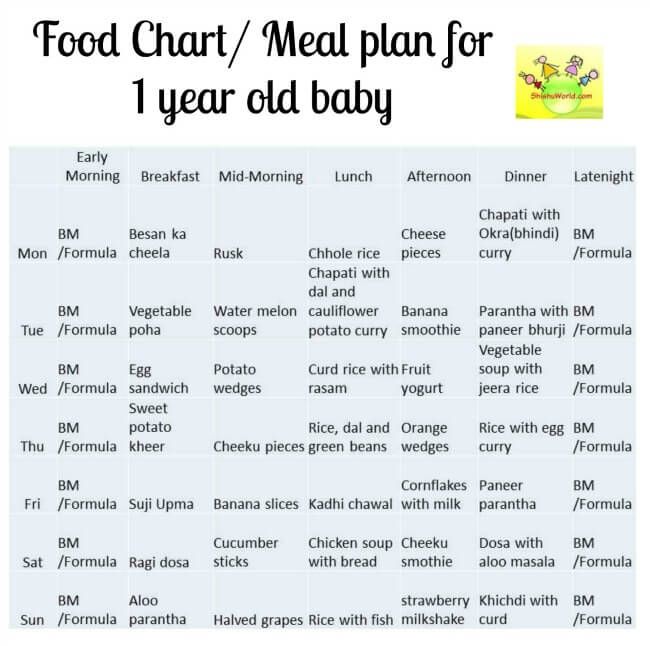
- The child should still not be given fried food. Particular preference should be given to steamed food. This is the best way to keep all the useful substances in the product. nine0018
- Minimize sweets, there should be practically no salt in the diet of the little one, and all kinds of seasonings, all the more so.
- The presence of a homogeneous mass in dishes is no longer only not necessary, but rather even superfluous. The child should already get used to more solid food. It is best to knead the dishes with a fork. The kid must learn to chew and develop the jaw.
- It is important that the child's diet includes: cereals, fruits, meat, vegetables, cottage cheese, fish and bread.
- Never force something into a baby's mouth that he has just refused. Don't get angry or shout. Most likely, it just didn't taste good. I am sure that you also have such products that you are indifferent or disgusted with. nine0018
- Foods from the so-called allergy risk zone still should not be given: red fruits and vegetables, exotic representatives, citrus fruits, chocolate, nuts, honey.

- Remember that baby milk should be diluted with water. At this age, you can 1:1.
- We should not forget that when we introduce new foods into a child's diet, we should do it slowly and gradually. You need to start with half a teaspoon. And only with a normal reaction of the body, bring to age norms. nine0018
- And don't forget to drink. The baby needs to replenish its fluid stores daily. Juices, decoctions, compotes, herbal teas, jelly are well suited for crumbs. And, of course, do not forget about the water itself.
Baby's diet
The baby keeps five meals a day. He still needs breastfeeding (sour milk or adapted formula) in the morning and before bedtime.
Breaks between meals can fluctuate around three to four hours. You already individually adapt to the requirements of the child and to what time he gets up and when he goes to bed. My son had four-hour breaks. He ate at 6, 10, 14, 18 and 22 hours. nine0003
To calculate how much food your baby should eat per day, just make calculations based on his weight.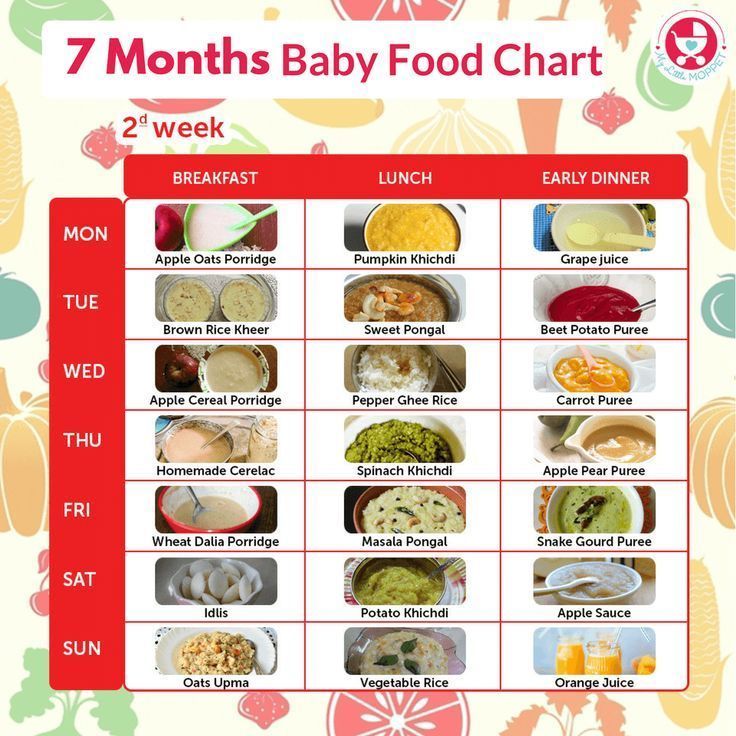 This figure in grams must be divided by nine. The answer will be the amount of food consumed. So, for example, my son already weighed 10 kg and 800 grams (10800), which means that he had to eat at least 1200 grams per day. Then you can divide the received answer into 5 meals and find out how much the child needs to eat in one feeding. In my case, this indicator was 240 grams. nine0003
This figure in grams must be divided by nine. The answer will be the amount of food consumed. So, for example, my son already weighed 10 kg and 800 grams (10800), which means that he had to eat at least 1200 grams per day. Then you can divide the received answer into 5 meals and find out how much the child needs to eat in one feeding. In my case, this indicator was 240 grams. nine0003
What can you feed a baby at 11 months
A baby should have a balanced diet, enriched with all the substances necessary for a growing body. And what exactly is included in his diet:
- Fruits and vegetables, berries. These are irreplaceable sources of vitamins, fiber and pectins. The kid should receive these products in full, corresponding to his age norms. From them you can already prepare different dishes: mashed potatoes, mousses, compotes, juices, jelly, puddings. And even the use of grated fruits in raw form is allowed, but in small quantities. nine0018
But do not forget that the baby's menu should not contain red fruits, citrus fruits and exotic representatives.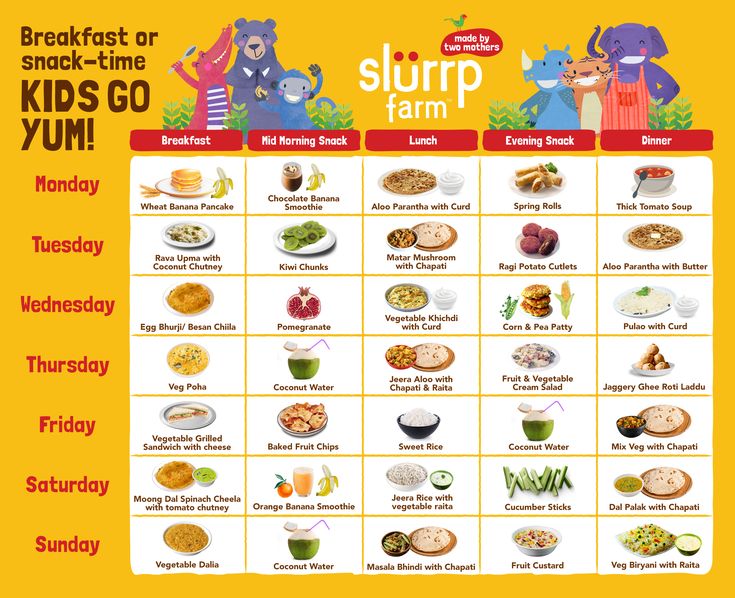
- An obligatory daily product is porridge. The most useful is considered to be oatmeal (but better not in the form of flakes). If the baby does not have celiac disease. It is better to cook such porridge on the water, and you just need to flavor the cooked product with oil. However, boiling in milk is also allowed, but do not forget that the baby should not be given whole milk, dilute it 1: 2 with water. Kasha is better to change every day. Buckwheat today, oatmeal tomorrow, rice the day after tomorrow, etc. nine0018
- Of course, meat dishes are an important component of a child's table. It can already be meatballs, steam cutlets, mousses, puddings. Try to give the meat in such a way that the little one tries to chew it on his own. Give preference to rabbit meat, turkey, chicken, veal, young lean pork. I gave my son only rabbit and veal until he was a year old.
- Fish should also be included in the baby's diet. The baby should still avoid the fatty varieties and the red varieties.
 nine0018
nine0018 - Cottage cheese, yogurt and kefir are important for the proper functioning of the digestive system. You can cook these foods yourself. Feel free to give dishes not only in their pure form, but also with the addition of already well-known fruits.
- Also, the baby can eat eggs, pasta, diet cookies, wheat bread, small amounts of oil are allowed to be added to ready-made meals (both vegetable and creamy), and the amount of salt and sugar should still be minimal. nine0018
Minimize your consumption of sweets. The baby is just getting its first teeth, and their development should not be disturbed. And, of course, the child’s diet should not yet contain chocolate, citrus fruits and other allergenic foods.
How can a baby's daily diet be presented? A fairly large number of products are already available to the baby. And what exactly can be the indicative menu of children for breastfeeding and IV? You can read about it below.
Breastfed babies
- at 6 in the morning and the first thing he reaches for his mother.
- By 10 o'clock the child was already hungry. At this time, give the little one porridge (you can use both milk and water) - 200 grams, no more. You can add 5 grams of oil to it. Also give the baby half the yolk. For dessert, offer the crumbs 50 grams of fruit puree. You can drink everything with compote or juice (50 ml). nine0018
- Lunch at the crumbs comes at 14:00. This feeding should be the most satisfying. It may consist of the following dishes: 200 grams of vegetable puree with oil (5 grams), 80 grams of puree, a slice of bread (from wheat flour, 10 grams). You can drink juice in a volume of 60 ml.
- At 18:00 - dinner at the little one. Give him 60 grams of fruit puree, 50 grams of cottage cheese, two biscuits. Let the child drink 200 ml of kefir.
- The last feeding comes before going to bed, at 10 am.
 And it's still breast milk. The baby will drink the volume necessary for full saturation. nine0018
And it's still breast milk. The baby will drink the volume necessary for full saturation. nine0018
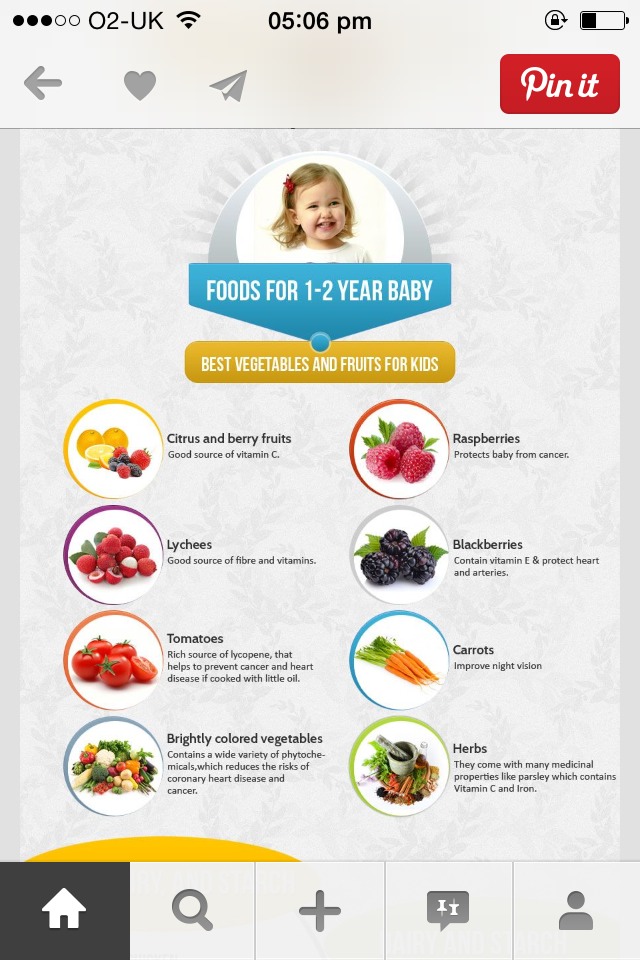 He's already hungry. The first feeding is still mother's milk (approximately 200 ml). It is still a very important source of nutrients for the development of the baby.
He's already hungry. The first feeding is still mother's milk (approximately 200 ml). It is still a very important source of nutrients for the development of the baby. Formula babies
- Breakfast starts at 6 o'clock. The first feeding is milk formula (200 ml).
- Reception to write between breakfast and lunch falls at 10 am. Feed the little one with any porridge cooked in any form. The baby needs 200 grams. Add 5 grams of butter. For dessert, 50 grams of fruit puree is well suited. Also offer your child half an egg yolk. You can drink food with 50 ml of juice.
- Meat soup (200 grams) is well suited for lunch feeding, which comes at 14:00. In addition, you can give your child 80 grams of vegetable puree, 10 grams of wheat bread. You can drink compote (60 ml). nine0018
- For dinner (18:00) give the baby 60 grams of puree (fruit) and 50 grams of cottage cheese. For a snack, give two crackers or biscuit cookies. A child can drink food with kefir (200 ml).
- And finally, at 22:00 hours, be sure to feed the little one with an adapted mixture (200 ml).

Recommended reading:
So we figured out what your child's diet should be now. The peanut is growing, and with it, food preferences are developing. Pamper your little one with a variety of foods. Make sure that he does not get bored, and he does not lose interest in some food. And, of course, you should not give the same thing every day, for example, oatmeal every day and no other cereals. This product will quickly become boring, and the baby will begin to spit on it. Therefore, plan the diet of the little one correctly, taking into account all the preferences of the baby. Try to make the menu varied and unique. May your child grow up healthy! nine0003
The menu of a breastfed baby at 11 months is similar to the diet at 10 months.
The baby is still enjoying its mother's milk, and complementary foods are becoming more diverse.
Contents
Properly compiling a diet and including all kinds of foods in the diet, you can please the baby and give him everything he needs for healthy growth.
What should be the diet
The menu already contains the main products, so breast milk in most feedings gives way to complementary foods. nine0003
Breastfeeding costs no more than 2 times a day.
If all new products are introduced on time, at 11 months you can start improving the taste of the menu items.
For example, when preparing vegetable and fruit dishes, it is better to use several types of fruits at once.
Babies need variety too. In addition, the more useful ingredients, the richer the dish is in the substances necessary for the body.
Portions of baby cottage cheese are best replaced with a casserole. It will be even tastier if you add fruit. nine0003
Variety is also important in drinks. This is especially true in summer. Compotes from different fruits and homemade yoghurts with the same filling will appeal to the baby.
Fruit drinks and jelly made from berries will be no less useful.
If the baby has not tried raw fruit before, at 11 months he can definitely be offered such a dessert.
If you add a few ingredients and smear the puree with a little sour cream, the child will surely eat the dish with great pleasure.
What should be the diet
According to WHO standards, at this age, the baby eats 5 times a day. This regimen is also advised by the pediatrician Dr. Komarovsky.
Breakfast and dinner before bedtime consist of mother's milk.
Treat the child with complementary foods three times a day. One feeding should be equal in volume to approximately 250 ml.
Helpful tips for mothers: NUTRITION BY MONTH
Feeding should take place at least every 4 hours. There is no need to offer food to the baby at night. nine0003
The daily amount of food is calculated according to the algorithm that has been in effect since 9 months.
The baby's weight is divided by 9. So, on average, a child absorbs up to 1250 grams per day. The maximum one-time volume of products remains the same as in 10 months.
| Vegetable Puree | 200 g |
| Fruit puree | 110 g |
| Meat | 80 g |
| Fish | 50 g |
| Yolk | ½ |
| Fruit juice | 110 ml |
| Rusk, biscuits | 10 g |
| Wheat bread | 10 g |
| Porridge | 200 g |
| Curd | 50 g |
| Dairy products | 200 g |
| Vegetable oil | 6 g |
| Butter | 5 g |
1-day baby menu at 11 months
Moms can find a sample menu specially designed for this age.
| 6.00 | Breast milk (200 ml). |
| 10.00 | Milk porridge (200 g) with butter (5 g), fruit (50 g), compote (50 ml). |
| 14.00 | Vegetable puree with cutlet (200 g), vegetable oil (6 g), bread (10 g), kissel (50 ml). nine0137 |
| 18.00 | Yoghurt (200 ml), cracker (10 g), cottage cheese (50 g). |
| 22.00 | Breast milk. |
Child's Weekly Meal
You can plan a weekly menu to buy the necessary groceries in advance. So you can be sure of the variety and nutritional value of the children's diet.
| 6 | nine0136 Breast milkBreast milk | Breast milk | Breast milk | Breast milk | Breast milk | Breast milk | |
| 10 | Corn porridge (200 g), butter, juice (60 ml). | Multi-cereal porridge (200 g), butter, half yolk, jelly (50 ml). | Semolina porridge (200 g), butter, compote (50 ml). | Buckwheat porridge (200 g), butter, half yolk, juice (50 ml). nine0137 | Oatmeal (200 g), butter, juice (100 ml). | Millet porridge (200 g), butter, half the yolk, jelly (100 ml). | Rice porridge (200 g), fruit puree (50 g), juice (50 ml). |
| 14 | Soup with meat and vegetables (200 g), apricot (50 g). | Mashed potatoes with liver (200 g), juice (100 ml). | Fish with buckwheat porridge (200 g), berry puree. | Meat soufflé (200 g), fruit puree (50 g). | nine0136 Soup with meatballs (200 ml), apple and carrot puree (50 g).Vegetables with fish (200 g), peaches (50 g), juice (50 ml). | Casserole with meat and vegetables (200 g), compote (100 ml). | |
| 18 | Yoghurt (200 ml), cottage cheese casserole (50 g), crouton. | Ryazhenka (200 ml), cottage cheese (50 g), biscuits. | Kefir (200 ml), cottage cheese (50 g), fruit puree. | Yoghurt (200 ml), cottage cheese (50 g), cracker. | Kefir (200 ml), cottage cheese (50 g), biscuits. nine0137 | Ryazhenka (200 ml), cottage cheese casserole (50 g). | Kefir (200 ml), cottage cheese (50 g), apple. |
| 22 | Breast milk | Breast milk | Breast milk | Breast milk | Breast milk | Breast milk | Breast milk |
Prohibitions and catering
Some mothers are so brave that they are ready to offer their baby any foods and dishes. But this is wrong. nine0003
Toddler is still not allowed:
- bold;
- smoked;
- fried;
- adult dairy and fermented milk products;
- nuts;
- citrus fruits.
Before offering a child a dubious product, it is worth remembering the possibility of allergies and other unpleasant reactions.
Whatever is tried for the first time must be given carefully and little by little.
Also recommended:
- pre-feeding; nine0018
- teach a child to drink from a mug;
- offer to get acquainted with the spoon and self-feeding;
- do not leave the child with food and drink alone.
The baby is getting older. He is already familiar with adult dishes that he can eat not only in the form of mashed potatoes.
Menu for a child at 11 months: recommendations of Dr. Komarovsky and other pediatricians
Proper nutrition is a key link in the chain of harmonious development of a child up to a year old. At 11 months, the baby has already received the first complementary foods, his diet is constantly expanding, he is actively interested in new tastes, gets acquainted with solid food. Some babies by this age are still breastfed or receiving formula milk, although several feedings have already been fully replaced with dishes from approved products. What menu for children at 11 months is recommended by leading pediatricians? nine0003
What menu for children at 11 months is recommended by leading pediatricians? nine0003
Content [show]
- Child menus at 11 months
- The basis of diet
- What eats a baby during breastfeeding
- DEPIRNING DRIVATION
- How much should a child should eat what should be given to children 11 months of
- Approximate menu for a child of 11 months per week
- 5 tips for parents
- Summing up
Menu for a child at 11 months
4 weeks before the first birthday, children have already acquired many skills and abilities. They actively move, learn about the world around them, make different sounds, imitating the speech of adults. Some babies are already taking their first steps. During this period, it is extremely important to provide the child's body with useful and nutritious substances for proper development.
For an 11-month-old baby, they continue to cook from products that have already been introduced into the diet. As experiments, parents can try different options for heat treatment, for example, vegetables for children's dishes can not only be boiled, but also baked or stewed. The texture of food also changes. It is time to gradually accustom the child to the common table, therefore, not only puree-like food is introduced into his menu, but also thicker. At this age, he already knows how to chew food, so fruits and vegetables are given in small pieces or mashed with a fork, meat is also cut. nine0003
As experiments, parents can try different options for heat treatment, for example, vegetables for children's dishes can not only be boiled, but also baked or stewed. The texture of food also changes. It is time to gradually accustom the child to the common table, therefore, not only puree-like food is introduced into his menu, but also thicker. At this age, he already knows how to chew food, so fruits and vegetables are given in small pieces or mashed with a fork, meat is also cut. nine0003
Pediatricians recommend not delaying the introduction of complementary foods. According to WHO standards, a child is introduced to new products gradually from 6 months. If complementary foods are introduced correctly, by the age of 11 months the baby is already well acquainted with the meat, fish and dairy products allowed to him, fruits, vegetables, cereals.
The basis of the diet
The main task of the parents is to introduce the child to the food groups that he will have to eat at the common table. Ingredients of plant and animal origin are prepared according to age-adapted children's recipes. This awakens nutritional interest, instills the right habits and nutrition culture, establishes a feeding regimen, and provides the baby's body with all the necessary micronutrients. nine0003
Ingredients of plant and animal origin are prepared according to age-adapted children's recipes. This awakens nutritional interest, instills the right habits and nutrition culture, establishes a feeding regimen, and provides the baby's body with all the necessary micronutrients. nine0003
Be sure to listen to your pediatrician's advice, including menu planning. The specialist will tell you in detail what is possible for a child at 11 months, and in what quantity.
By 11 months, the baby should eat a varied diet. Neither breast milk nor formula can fully replenish the nutrients and calories that a growing body needs. For children of this age, the basic diet is:
- Cereal porridge from buckwheat, rice, oats, millet, wheat and others. They can be cooked both separately and combined. nine0018
- Vegetables. Used to make soups and casseroles, combine several different types.
- Fruit. They are chosen taking into account seasonality, for example, apples and bananas can be given all year round, and strawberries and apricots only in summer.

- Dairy products. Kefir, yogurt, cottage cheese must be included in the children's menu, because they contain a lot of calcium and bacteria that are beneficial for the intestinal microflora.
- Meat. Animal protein is essential for the growth of muscle tissue, so feed the crumbs with meat broths, meatballs, steam cutlets should be 3-4 times a week. nine0018
- Egg yolk. It is a source of proteins and fats, folic and pantothenic acids, B vitamins.
- Fish. For children, low-fat varieties are chosen, for example, pollock, river perch, hake - they are prepared 1-2 times a week.
- Bakery products. These are children's or biscuit cookies, white bread, cereal bread.
An 11-month-old baby needs not only enough food, but also water. You don’t need to focus on the volume, just provide the crumbs with access to drinking liquids if desired. nine0003
Pediatricians recommend breastfeeding after each solid meal to help maintain lactation.

What does a baby eat while breastfeeding
Mother's milk fully satisfies the needs of the baby up to 6 months. It contains all the necessary nutrients, vitamins, trace elements. After six months, the diet of active children cannot consist only of breast milk. By this time, its composition and calorie content are changing, it becomes impossible to cover all the needs of a growing organism. nine0003
No more than two breastfeeds left by 11 months. We are not talking about weaning from breastfeeding if neither mother nor baby is ready for this. However, to replenish the supply of trace elements and prevent nutritional problems in general, the diet needs to be expanded.
Don't be afraid to experiment. At 11 months, the child is already familiar with many products, so a variety of dishes can be prepared from them. For example, instead of fruit juice, offer jelly, and cook a casserole from cottage cheese, eggs and a banana. nine0003
Formula-fed diet
If, for any reason, a baby is fed formula instead of breast milk, complete complementary foods are essential. At 11 months, adapted baby food is left for 1 or 2 feedings. It can be a morning breakfast right after waking up or a bottle at night. During the day, the baby is offered solid food, which he studies and tastes with interest.
At 11 months, adapted baby food is left for 1 or 2 feedings. It can be a morning breakfast right after waking up or a bottle at night. During the day, the baby is offered solid food, which he studies and tastes with interest.
For artificial children, the pediatrician can slightly shift the timing of the introduction of complementary foods. The first vegetables are offered to babies as early as 4.5-5 months. By the age of 11 months, children are already familiar with most of the foods that are customary to eat in the family. nine0003
How much a child should eat
Many parents think that the more the baby eats, the better. In fact, the child should eat as much as he wants, forcing him to absorb impressive amounts of food is unhealthy. This is fraught with problems with the gastrointestinal tract, as well as the formation of improper eating habits and weight gain.
Pediatricians advise to follow the daily allowance:
- vegetable puree - 150 g;
- fruit puree - 100 g; nine0018
- porridge - 200 g;
- boiled meat - 50 g;
- fish - 30–60 g;
- fermented milk drinks - 200 ml;
- cottage cheese - 50 g;
- boiled yolk - ½ part;
- biscuits and bread - up to 15 g;
- butter - 1 tsp.

At one meal, the child should not eat more than 300-350 ml (this is the total amount of both solid and liquid food). The volume of food per day is approximately 1200-1300 ml. Babies at 11 months need at least 750 calories per day, part of which comes from breast milk or formula. nine0003
For 11-month-old babies, attachment to the breast is no longer a way to satisfy the need for food, but an opportunity to calm the nervous system.
What not to give to children 11 months old
Despite the fact that by the age of eleven months babies have tried a lot of foods, they are forbidden to give:
- smoked fish and caviar;
- prepared foods and sausages;
- seafood;
- processed, sharp and moldy cheeses; nine0018
- cakes and pastries with artificial colors;
- sauces, condiments and spices;
- mushrooms;
- nuts;
- exotic fruits;
- carbonated drinks.

Skip extra snacks, sweets and pickles.
Sample menu for an 11-month-old child for a week
Do not know what to feed your baby to diversify and balance his diet? We offer a sample menu for the week.
Monday
| 06:00 | Breast milk or mixture |
| 10:00 | KUKURUZA porridge with butter, apple |
| 14:00 14:00 14:00 14:00 14:00 14:00 14:00 14:00 14:00 14:00 14:00 14:00 14:00 14:00 14:00 14:00 14:00 14:00 PM Bread, banana | |
| 18:00 | Curd casserole, yogurt, cookies |
| 22:00 | Breast milk or mixture | Porridge millet, butter, ½ yolk, peach juice |
| 14:00 | Meat souffle, grated apple with carrots | 18:00 | CREMIRIC or BARANCH, COMROP | , KAFERIA, KAFER : 00Breast milk or mixture |
Friday
| 06:00 | Breast milk or mixture | 90:00 7
| 14:00 | Soup with meat meatballs and vegetables, white bread, apricot puree |
| 18:00 | Yogurt, bellows | 22 2:00 |
Saturday
| 06:00 | Breast milk or mixture |
| 10:00 | Multizlakaya porridge, oil, brothels, colorful Kavli0003 You might find the American Academy of Pediatrics guidelines helpful when planning your 11-month-old baby's menu:
5 Tips for Parents
|

 The finished product with fruit additives is adapted to the child's digestive system and contains many valuable trace elements. Add finely chopped or mashed fruits with a fork to homemade cereal porridges to make the dish both tastier and healthier. nine0018
The finished product with fruit additives is adapted to the child's digestive system and contains many valuable trace elements. Add finely chopped or mashed fruits with a fork to homemade cereal porridges to make the dish both tastier and healthier. nine0018 
